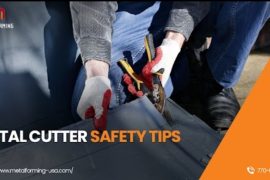When working with metal cutters, you should always ensure that you are protecting yourself and others around you. This is because metal cutters, both automated and manual equipment, can have very sharp edges and components that can injure you. If you have just bought your first metal cutter, follow this guide to make sure that you keep yourself safe and create a safer working environment.
What are Metal Cutters?
As the name suggests, metal cutters are equipment that are used to cut metal sheets into the desired shape. Metal cutters are available in both manual and automated options. With manual cutters, you need to focus more on achieving precision and accuracy. Automated metal cutters like the ones available at Metalforming are integrated with the latest technology. They require less man power and can enable you to achieve high efficiency and productivity.
The importance of Safety when using Metal Cutter
Using metal cutters requires you to adhere to safety guidelines strictly. If you are not vigilant and mishandle any equipment, you may suffer from injuries that could also become life thretening. Some of the most common injuries that have been reported due to the misuse of metal cutters include:
- Cuts and abrasions
- Eye injuries
- Skin burns
- Fumes and chemical poisoning
Types of Metal Cutters
Some common types of metal cutter include:
- Shears:
- Hand Shears: Manual scissors-like tools used for cutting thin metal sheets.
- Tin Snips: Specifically designed for cutting tin. They come in left-cutting, right-cutting, and straight-cutting varieties.
- Guillotine Shears: Large machines that cut metal sheets with a straight blade, either mechanically or hydraulically powered.
- Hacksaws:
Manual saws with replaceable blades designed for cutting metal.
- Chop Saws:
Similar to miter saws, but equipped with abrasive or metal cutting blades to handle metal.
- Angle Grinders:
Handheld power tools equipped with abrasive discs that can be used for cutting metal, grinding, and polishing.
- Plasma Cutters:
Uses an electric arc and compressed gas to cut metals. Suitable for cutting thick metal and allows for precise and clean cuts.
- Oxy-Acetylene Torches:
Uses a combination of oxygen and acetylene gas to produce a very hot flame capable of cutting through metal.
- Laser Cutters:
Uses focused laser beams to cut precise patterns and designs on metal sheets. Ideal for intricate designs.
- Water Jet Cutters:
Uses high-pressure water mixed with abrasive materials to cut through metal.
Safety Tips – Metal Cutters
Working with metal cutters is highly dangerous and can also prove to be fatal if proper care is not taken when operating them. The following safety precautions will also help you in protecting yourself and others around you from the potential hazards of working with metal cutting equipment.
- Wear Protective Equipment.
Working with metal cutters means you are always exposed to the danger of getting hurt physically. It is therefore important to wear the right PPE. You should always wear eye protection, hearing protection and steel-toed footwear. When operating the machines, wear gloves that are made of heavy-duty materials. Avoid loose-fitted clothing as there is a chance your clothes might get caught into the machine parts.
- Inspect your tools
Always assess your tools and make sure they are in good working condition. Look out for signs of wear and tear. Make sure all of the parts are attached correctly.
Regularly schedule maintenance checks to ensure that your machines are not damaged.
- Keep your work area clean
Make sure that your workspace does not have any objects lying around that are not needed. Otherwise you might trip and injure yourself. Keep removing debris and metal leftovers once you have finished your operations.
- Follow manufacturer’s instructions
Keep your instructional manuals at hand when you are in your workspace. Make sure these manuals are accessible to your whole team as well to maintain a safe working environment.
- Keep your hands away from the cutter
Metal cutters are sharp. These blades can pierce through your skin and cause serious injuries. Always make sure your hands are away from these blades. Wear gloves to avoid any damage to your hands.
- Operate metal cutters only if you are trained
Metal cutter operators undergo specific training, which also includes a module on the best safety practices. If you have not received this training, or are inexperienced, it is best to leave this job to those who have been trained.
- Be prepared for emergencies
Always have your first aid kits ready in your workzone. You should be familiar with the contents of these first aid kits and how to use them properly, if need be. You should also be familiar with the locations of emergency shut-down buttons.

Safety Training at Metalforming
When you purchase metal cutters from Metalforming, you will have access to Training for Life and Service for Life programs to keep your equipment and employees working effectively and safely. We ensure that your workers are fully trained before they can begin using metal cutters and other metal fabrication equipment. We also offer regularly scheduled preventative maintenance (PM), enhanced remote support and replacement parts packages.
Metalforming, LLC- For all of your Sheet Metal Fabrication needs
We proudly collaborate with a number of the world’s leading metal forming fabrication equipment companies, including Jorns, Schechtl, Schlebach, Krasser and Schroder Group. Our facility in Peachtree CIty is always stocked with all of the latest equipment including sheet metal forming machines, slitters, decoilers and much more. We also offer training sessions and seminars to help you understand the latest innovations in sheet metal fabrication processes. For more information about our products and services, visit our website metalforming or get in touch with us directly.


